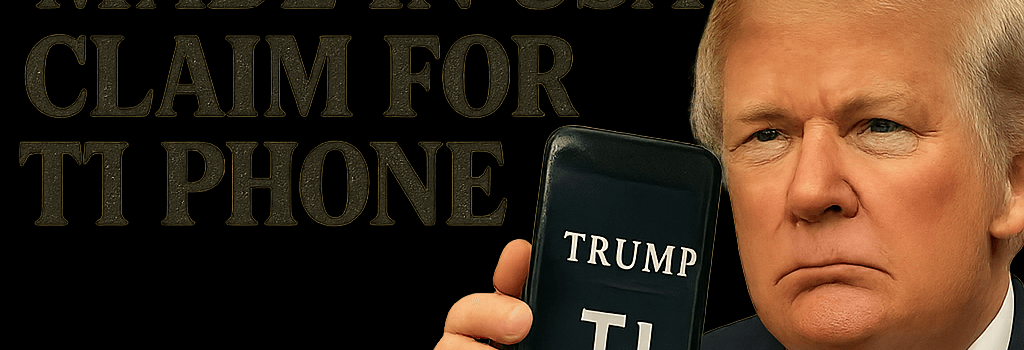Trump Mobile Retreats on ‘Made in USA’ Claim for T1 Phone

When Trump Mobile unveiled its $500 T1 Phone last month, the centerpiece of the marketing campaign was that the device would be 100% made in the United States. Within days, supply‐chain experts questioned the feasibility of domestic production. Now, the Trump Mobile website has quietly removed the “MADE IN THE USA” banner, replacing it with the claim that the T1 is merely “designed with American values in mind.”
Claim Retraction and Public Timeline
- June 16, 2025: Press release announces the T1 as “proudly designed and built in the United States.”
- June 18–22, 2025: Tech media—The Verge, Ars Technica, Bloomberg—flag doubts about domestic assembly.
- June 24, 2025: Website updated to remove explicit “Made in the USA” language; availability pushed from August to “later this year.”
- June 25, 2025: Trump Mobile spokesperson insists “The T1 phones are proudly being made in America,” but declines to specify factories or vendors.
Technical Specifications: What We Know
While Trump Mobile has been opaque about the exact bill of materials (BOM), teardown enthusiasts and industry observers note strong similarities between the T1 and the REVVL 7 Pro 5G from Chinese original design manufacturer Wingtech. Key specs include:
- Processor: Qualcomm Snapdragon 695 5G (Octa-core, 2×2.2 GHz Cortex-A78 + 6×1.7 GHz Cortex-A55)
- Display: 6.25-inch AMOLED, 2400×1080 px, 120 Hz refresh rate
- Memory & Storage: 6 GB LPDDR4X RAM, 128 GB UFS 2.2
- Camera: 50 MP Sony IMX766 main, 8 MP ultra-wide, 2 MP depth sensor
- Battery & Charging: 4,500 mAh, 30 W wired fast-charge
- Connectivity: Dual-SIM, sub-6 GHz 5G, Wi-Fi 6, Bluetooth 5.2, NFC
Note: The Trump Mobile site initially listed a 6.78-inch panel—matching the REVVL 7 Pro—but has since revised it to 6.25 inches. Experts interpret this as an effort to disguise the device’s ODM origins.
Supply Chain Realities of American Smartphone Assembly
Assembling modern smartphones requires tier-1 suppliers for chips (TSMC, Qualcomm), display panels (Samsung, LG or BOE), camera modules (Sony, Omnivision) and memory (SK Hynix). Nearly all these components are manufactured in Asia:
- Semiconductor wafers: Taiwan & South Korea
- Displays: South Korea & China
- Assembly: Predominantly China and Vietnam
Moving even final assembly to the U.S. would demand new capital expenditures in tooling, workforce training, and logistics. According to Supply Chain Insights analyst Dr. Rachel Kim, “Even if you place final assembly stateside, the high‐precision pick-and-place machines and test jigs are 90% sourced overseas. A true ‘Made in USA’ phone today remains aspirational without years of investment.”
Comparative Performance and Pricing
At $500 retail, the T1 costs twice as much as its spec-twin REVVL 7 Pro 5G on T-Mobile ($250). Benchmarks from Geekbench 6 show nearly identical multi-core scores (around 2,800), indicating no hardware or firmware tweaks to justify the premium. Value analysts suggest Trump Mobile may be leveraging brand affinity over performance:
“You’re paying for a logo, not a Silicon-Valley-tuned experience,” says tech consultant Mark Fields of StreetMetrics. “Under the hood, the T1 remains a mid-range, off-the-shelf ODM device.”
MVNO Partnership and Activation Quirks
Trump Mobile is an MVNO (Mobile Virtual Network Operator) that resells capacity from major carriers—likely T-Mobile and AT&T. The sign-up process involves:
- Online registration with identity verification
- Provisioning via eSIM or physical SIM from a small Florida telecom partner
- No official app; activation requires manual APN settings
Civil-engineering professor Dr. Elena Rossi warns that “MVNOs can face service degradation during network handovers or heavy-load events if they’re not prioritized by host carriers.”
Regulatory and Trade‐Policy Implications
President Trump’s previous tariff campaigns targeted Chinese imports, pressuring firms like Apple to consider U.S. assembly. Yet large-scale reshoring has not materialized. The International Trade Commission confirms that, to date, no smartphone OEM has established high-volume U.S. manufacturing lines for advanced 5G handsets. Crafting a “Made in USA” narrative without underlying infrastructure could draw scrutiny under the Federal Trade Commission’s Made in USA Labeling Rule.
Looking Ahead: Can ‘American Values’ Become American Reality?
Eric Trump recently clarified in an interview that “eventually all the phones can be built in the United States of America,” suggesting that full domestic assembly remains a long-term goal, not present reality. For now, the T1 stands as a case study in branding versus engineering substance.
Key Takeaways
- The explicit “Made in the USA” claim has been removed, replaced with ambiguous “American-designed” language.
- Technical teardown points to a re‐branded Chinese ODM device, with no substantive U.S. manufacturing revealed.
- True domestic assembly of modern 5G smartphones would require massive new investments that no OEM has undertaken yet.